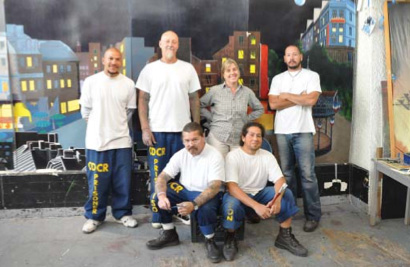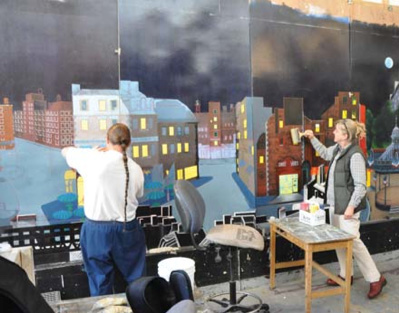“William James Association Promotes S.Q. Arts Project”
Republished from San Quentin News -Â VOL. 2013 NO. 11 -Â November 2013
By Boston Woodard, Staff Writer
The William James Association (WJA) is an organization that promotes work services in the arts, environment, and education. In addition, community development currently provides the Prison Arts Project for prisoners.
“The biggest thing about the Prison Arts Project is it’s inspiring,†said Laurie Brooks, Executive Director of the William James Association. “It allows people to rise above their circumstances to find the beauty in their art. Art has a way of uniting everyone, especially through music,†she said. Brooks has been with the WJA since 1989. According to Brooks, there are currently 10 arts facilitators assigned to the San Quentin Arts Project.
The WJA is a nonprofit community service corporation founded in 1973 by Page Smith and Paul Lee. The association was named after an American philosopher William James, who was deeply concerned with the relationship between philosophical thought and social action. Through the vision and efforts of Eloise Smith, the WJA began the Prison Arts Project in 1977 as a pilot program at the California Medical Facility (CMF) prison in Vacaville. Since that time, the WJA has dedicated itself to providing arts experiences to incarcerated individuals in the belief that participation in the artistic process significantly and positively affects one’s views of oneself and the world. Professional artists provide in-depth, long-term arts experiences for incarcerated men and women. The program selects and hires professional visual, literary and performing artists to teach in California state prison facilities. It also establishes Artists-in-Residence programs for the National Endowment for the Arts and the Federal Bureau of Prisons.
There also has been much interest by some elected officials regarding the positive possibilities of arts being part of the bigger picture. In 1980, State Senator Henry Mello was responsible for getting legislation passed to expand the Arts in Corrections (AIC) programs.
Jack Bowers, WJA Chairman of the Board of Directors based in Santa Cruz, began working at Soledad State Prison as a music instructor with the AIC program. He understands the significance of doing something beneficial for prisoners. Bowers was successful with his effort to instill the qualities necessary to become a good all-around musician, and he intimately understands the rehabilitation and inestimable benefits of such programs.
Brooks is an artist, a potter by trade who has been with the William James Association since 1989. According to Brooks, “The WJA is also sponsoring a film screening to benefit the Prison Arts Project, At Night I Fly (Images from New Folsom Prison), a film by Michel Wenzer.â€
The benefit organizers wrote, “Images from New Folsom, men at one of California’s most maximum security prisons, let us see their world. At Night I Fly shows the artistic human journey these men take, as well as the need that fuels it, and the beauty and pain encountered along the way.â€

Top row:Justus Evans, Bruce Fowler, Laurie Brooks, Scott McKinstry, Bottom row: James Norton and Christopher Christensen – Photo by Steve Emrick
The San Quentin Prison Arts Project is presently working on a huge mural comprised of sixteen 4’x8’ panels that will be displayed in San Quentin’s North Dinning Hall.
Scott McKinstry said, “Laurie and Steve Emrick [Community Partnership Manager], got the William James Association to run the Prison Arts Project here.â€
Brooks told the San Quentin News, “I have six artists working on this composition.†Work on the mural is in a small art studio crammed with musicians/band equipment and actors involved with the Marin Shakespeare Theater Company on a daily rotating basis. With limited workspace and time the artists managed to trek on, determined to complete this creative undertaking.
“Art has had a positive affect on my life and keeps me away from trouble,†said artist James Norton.
According to Brooks, “Art programs in prison are vital. That’s why I’m involved. The contact is special—it’s freedom, it’s a place of individualism. You have to go with the flow working in this environment; it’s a different reality in prison making it all work under the circumstances. We try to keep the program constant and moving forward.†When asked about the PBS film project just completed about arts programs in San Quentin, featuring prisoner/artist “Santos,†Brooks said, “It was wonderful that Santos was allowed to undergo that artful mission. Someone in charge took a risk and 70 years later it’s being recognized.â€
Emmy Award winning documentary filmmakers, Paul and Lori Sutton, a husband and wife team at San Diego State University, spent three days in October filming and recording Santos’s massive World War II era murals in San Quentin’s West Chow Halls, the current mural project, the Marin Shakespeare Theater Company and San Quentin’s Wall City Band.
According to Brooks, the William James Association is funded in part by the Puffin Foundation and Indiegogo.com, a crowd-sharing group who also donated funding for the mural. The Marin County Foundation and the Kalliopeia Foundation contribute to the WJA as well. David Kaun, Professor of Economics at UCSC, and Santa Cruz writer Quentin Hancock are also major contributors to the WJA.
In 2010, state funding for arts facilitators was eliminated. The WJA partnered up with Bread & Roses and the Marin Shakespeare Theater Company to continue bringing professional artists and teachers into California’s prison system. This corroboration allows art facilitators to continue bringing music, painting, acting and songwriting workshops into the prison system.
“We are fortunate that Laurie brings other artists in who encourage us to stay with it,†said Norton. The California Rehabilitation Oversight Board (CROB) is an important group whose board members include Inspector General Robert A. Barton, Secretary of the CDCR Jeffrey Beard and Administrator of Adult Education Programs Patricia S. Terry. In a September 2013 report, the group wrote: “Effective programming is essential to reducing recidivism, and offenders who participate in arts programs have lower rates of recidivism. The board reviewed the Arts in Corrections pilot program and is pleased with the initial results. The department should continue working toward developing a dedicated Arts in Corrections program, to be administered statewide.†The C-ROB board is pleased with the initial results from the Arts in Corrections pilot program, and said they are aware that offenders who engage in arts programs experience better parole outcomes and lower rates of recidivism. “The board recommends the department continue to work collaboratively with the California Arts Council Lawyers Association to develop dedicated arts in corrections programs to be administered statewide.â€
“The art program is very important because studies show that disciplinary and recidivism rates are lowered,†said McKinstry.
Brooks said, “Working with the California Lawyers Association for the arts is wonderful. They help us to restore funding for the arts, and with Legislative and Senate hearings.â€
The Joint Committee on the Arts held hearings in Los Angeles at the Grammy Museum Auditorium. Speakers/advocates for Arts in Corrections Program who spoke at the event included Jack Bowers, Jim Carlson, Laurie Brooks, Wayne Cook, Craig Watson and Wayne Krammer— rock guitarist for the legendary 60s mega-group MC-5. Krammer started the program Jail Guitar Doors (the name came from a song written about Krammer by The Clash when he went to jail). Krammer donates guitars to incarcerated men and women.
In September the CBS Sunday Morning show ran a segment on prison art programs. Hollywood actor Tim Robbins was featured at the California Rehabilitation Center highlighting that prison’s theatre programs. Some men and women involved with the arts continue to grow as artists with their involvement in reentry programs such as the Poetic Justice Project based in Santa Maria California, made possible by artist/writer Deborah Tobola.
Brooks said, “It’s gratifying to be a part of the talent behind these walls. It’s an opportunity for San Quentin artists to display their talent. We as WJA artists/ facilitators have this great opportunity to be part of the creativity demonstrate by those involved with the program.â€



